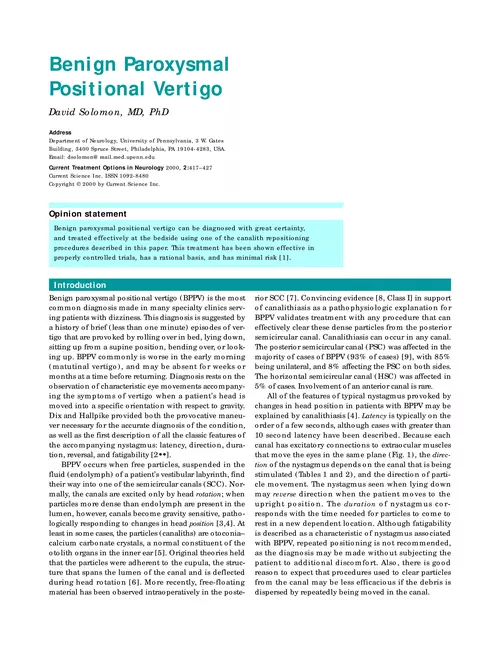
Benign Paroxysmal Positional Vertigo
lolithiasis, which is a form of BPPV less responsive tion exercises, Brandt--Daroff exercises, or patient to treatinent maneuvers.
adsPart of the document
Introduction
Benign paroxysmal positional vertigo (BPPV) is the most
common diagnosis made in many specialty clinics serv-
ing patients with dizziness. This diagnosis is suggested by
a history of brief (less than one minute) episodes of ver-
tigo that are provoked by rolling over in bed, lying down,
sitting up from a supine position, bending over, or look-
ing up. BPPV commonly is worse in the early morning
(matutinal vertigo), and may be absent for weeks or
months at a time before returning. Diagnosis rests on the
observation of characteristic eye movements accompany-
ing the symptoms of vertigo when a patient"s head is
moved into a specific orientation with respect to gravity.
Dix and Hallpike provided both the provocative maneu-
ver necessary for the accurate diagnosis of the condition,
as well as the first description of all the classic features of
the accompanying nystagmus: latency, direction, dura-
tion, reversal, and fatigability [2••].
BPPV occurs when free particles, suspended in the
fluid (endolymph) of a patient"s vestibular labyrinth, find
their way into one of the semicircular canals (SCC). Nor-
mally, the canals are excited only by head rotation; when
particles more dense than endolymph are present in the
lumen, however, canals become gravity sensitive, patho-
logically responding to changes in head position [3,4]. At
least in some cases, the particles (canaliths) are otoconia-
calcium carbonate crystals, a normal constituent of the
otolith organs in the inner ear [5]. Original theories held
that the particles were adherent to the cupula, the struc-
ture that spans the lumen of the canal and is deflected
during head rotation [6]. More recently, free-floating
material has been observed intraoperatively in the poste-rior SCC [7]. Convincing evidence [8, Class I] in support
of canalithiasis as a pathophysiologic explanation for
BPPV validates treatment with any procedure that can
effectively clear these dense particles from the posterior
semicircular canal.


